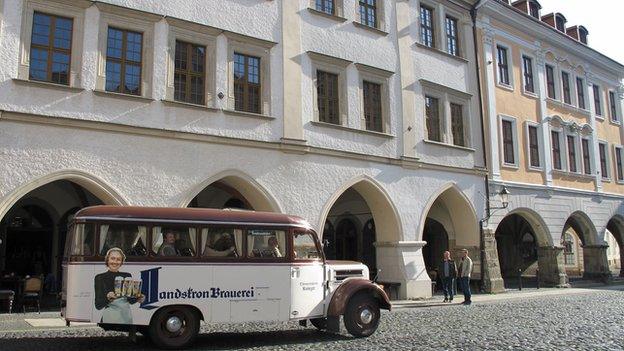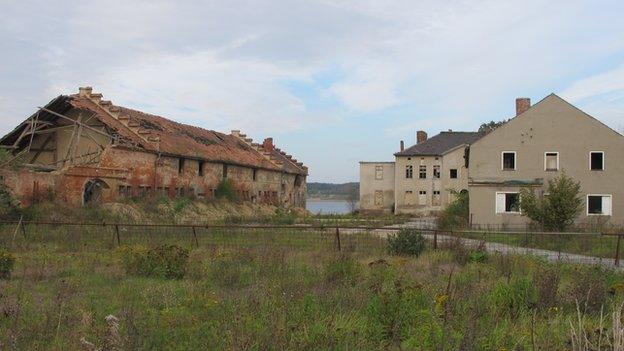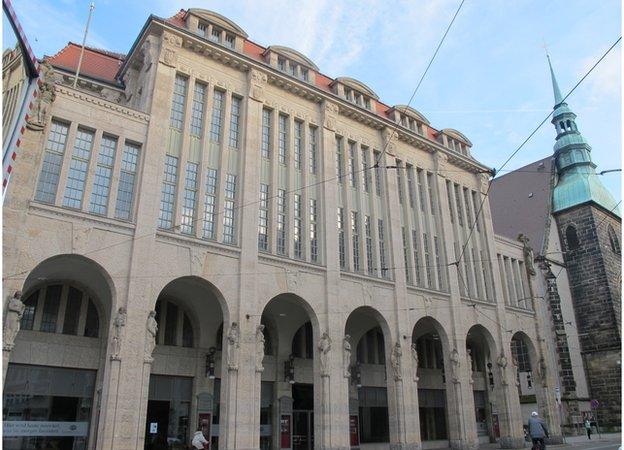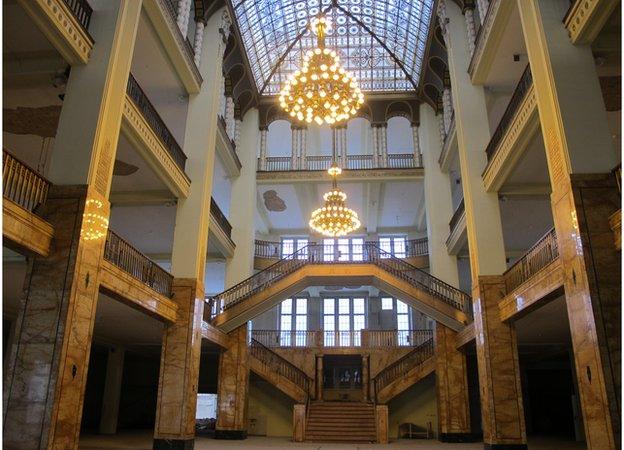Germany looks east for new customers
- Published

Walk the streets of modern Berlin today, and you'd be hard pressed to spot the join between the old West and East Germany.
Twenty-five years after the long-detested "Iron Curtain" was torn down by people power, there's little left beyond the many monuments along the old route.
Yet travel some 200km (125 miles) to Germany's most easterly city, Goerlitz, and the legacy of 1989's abrupt change in the ruling political and financial system has a much longer tail.
Certainly the roads and communications provide little clue to the City's GDR past. The region shared in the fruits of the 2 trillion euros (£1.6tn) worth of rebuilding work paid for by West German taxpayers.
But in common with most of the old East Germany, the initial surge of departing young economic migrants left behind lower birth rates, higher unemployment and an ageing population.
Stemming the tide
For a poignant reminder of how economic life has changed, it's worth visiting the town's Berzdorfer See. It's a vast lake of around 20 sq km - one of the largest in Saxony and made by flooding a redundant lignite mine.

Abandoned buildings litter one side of the Berzdorfer See
Today there's a beach for swimmers, waterside tracks for cyclists and joggers, and some perfect sites for boating and leisure investments. That's if suitable entrepreneurs can ever be found.
Yet the site is also a reminder of how the fall of communism turned financial life upside down. One shore is dotted with abandoned factory buildings and homes - untouched since the last state workers lost their livelihoods.
With about 56,000 inhabitants, Goerlitz has managed to hold on to little more than half of its population prior to German unification.
Thomas Klatte leads Europastadt Goerlitz, an organisation working to drum up new visitor and commercial interest in the city. He says the good news is that Gorlitz appears to have finally stemmed the tide of people of working age leaving with their families to find a living elsewhere.
"The economical structure was concentrated on the textile industry and brown coal mining, and there was a huge energy plant. All these activities have almost completely disappeared.
"But we do have two core employers today - a huge railway coach building company and a company manufacturing turbines. All of these have many smaller local suppliers. One of our targets is to attract new firms to offer more people a future here in the region, because many who live here still commute to Western Germany."
The town of Goerlitz is hoping to restore its fortunes, as Nigel Cassidy reports
'Goerlywood'
But head into the city centre - metres from the Polish border - and things are definitely looking up. The old town certainly looks rich because of its huge range of mercantile houses.
Some claim Goerlitz is the most beautiful city in Germany. Certainly, nowhere in the former East Germany has such a mix of well-preserved buildings - be they medieval, baroque, gothic or renaissance.
It is one reason why tourism has become an important industry.
And just as the northern Spanish town of Bilbao was famously revived by the opening of the Guggenheim Museum, Goerlitz is pinning its hopes on a new cultural and commercial landmark in the making. A cool 20m euros is being lavished by private investor Winfried Stocker on restoring a 1913 art nouveau department store as an upmarket, luxury department store.

The Kaufhaus Goerlitz was built in the art nouveau style

Recognise the inside?
And if you think those staircases, distinctive windows and chandeliers look familiar, you'd be right. The Kaufhaus Goerlitz building was the set for director Wes Anderson's comedy movie The Grand Budapest Hotel. In fact the whole city is being dubbed "Goerlywood" for its many exquisite period locations.
Looking east
But it is unlikely that such an ambitious project could be sustained by local spending power alone. Wages in this relatively impoverished Saxony region remain up to 25% lower than those in the old West Germany.
It is also fair to say that local shopping tastes veer towards the practical rather than the designer labels. It's one reason why the store's instigators are planning a mix of in-house retailers and merchandise that will appeal to visitors from just across the border in faster-growing Poland and the Czech Republic.
It is a good illustration of a broader trend. Having spent 25 years looking westwards to upgrade standards and methods, German businesses are now turning their attention towards the east.

Businesses should grab the opportunity to sell to eastern Europe, says Juergen Friedel
Prof Juergen Friedel is project leader for Kaufhaus Goerlitz. He says local retailers already made around a third of their revenue from Polish customers.
"Goerlitz has a lot of chances because it's such a great and well-preserved city for people to visit. Poland is only 600m from the department store - you can just walk across the bridge and you are there.
"The economy has been growing well in Poland and the Czech Republic, and people are earning more money than in years before. It's one reason why Western Germany has been looking more to the east, not just to Poland but Ukraine, Russia. This is a very good opportunity for companies to get experience selling to the eastern part of Europe."
Spending debate
What nobody quite expected was that, the 25th anniversary of reunification would also coincide with an unexpected downturn in orders and confidence in the country as a whole. In particular, criticism has centred on government policies to hold down public expenditure and wages.
Some economists are saying it is time for what amounts to a re-run of the kind of spending that boosted fortunes in Eastern Germany after reunification, only this time targeting cold spots in the whole of Germany.

Goerlitz as seen from just over the border in Poland
Robert Schwar is a senior project manager with Erdmann, a successful Goerlitz software company that analyses data on the state of railway tracks.
You might say his is just the kind of enterprise that might benefit from a new round of infrastructure investment. But Mr Schwar is convinced Germany would be better advised to ride out any setbacks, sticking to what he sees as a proven course that has allowed small and medium-sized enterprises such as Erdmann to prosper and enjoy export success.
"I'm not sure we need a new wave of investment," he says. "The German system has served and supported businesses well compared to anywhere else in Europe. Communicating our strengths to customers is more important."
Unification spelt the end for Goerlitz's state industries. But 25 years on, the hope is that the town's strategic location halfway between Berlin and Prague will herald new opportunities.
It can certainly offer good quality vocational education. And it has something even Berlin can no longer boast - plenty of low- cost housing for rent. But what is clear is that filling many of the town's still empty old haunts with new life may take at least another 25 years.